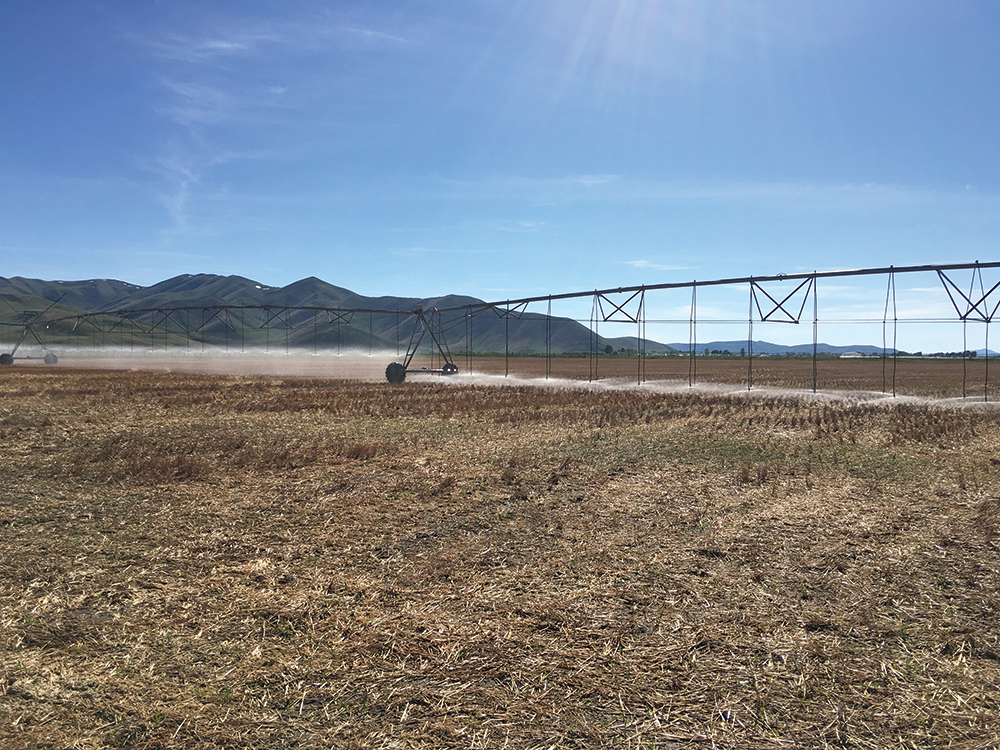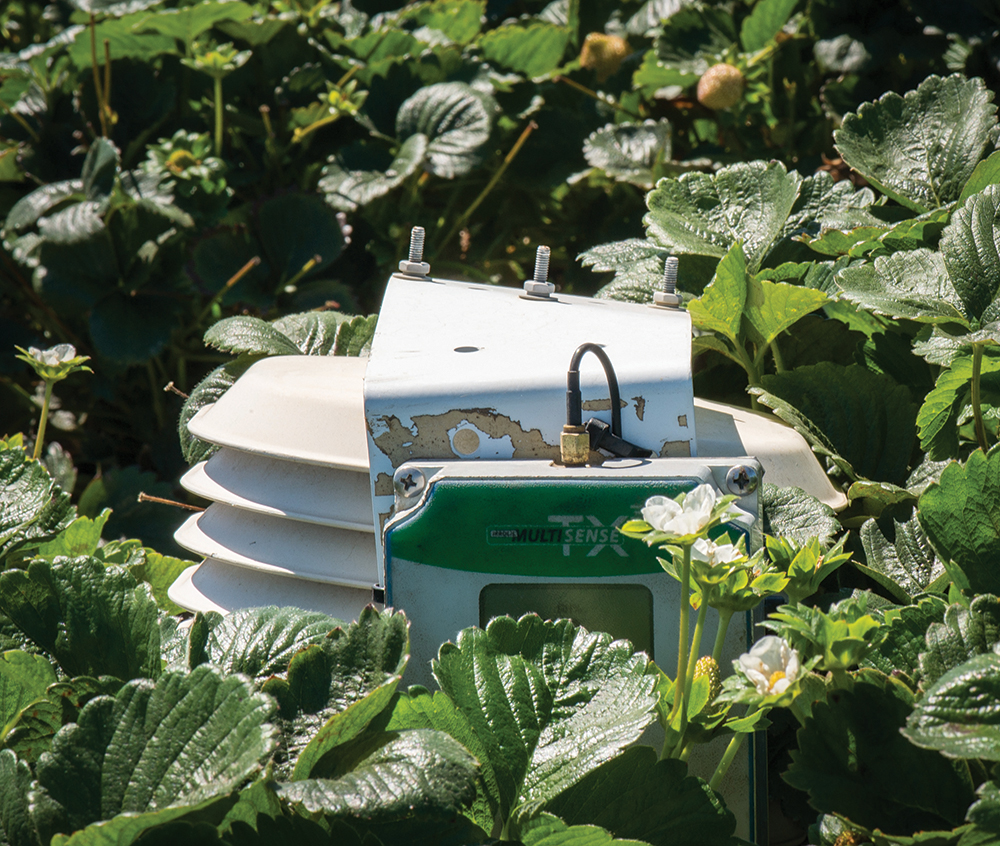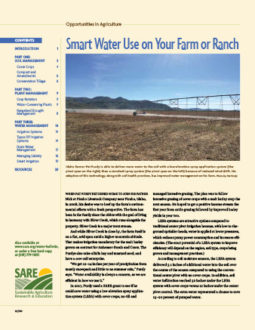
When Pat Purdy returned home to join his father Nick at Picabo Livestock Company near Picabo, Idaho, in 2008, his desire was to beef up the farm’s environmental efforts with a fresh perspective. The farm has been in the family since the 1880s with the goal of living in harmony with Silver Creek, which runs alongside the property. Silver Creek is a major trout stream.
And while Silver Creek is close by, the farm itself is on a flat, arid span amid a higher mountain altitude. That makes irrigation mandatory for the malt barley grown on contract for Anheuser-Busch and Coors. The Purdys also raise alfalfa hay and mustard seed, and have a cow-calf enterprise.
“We get 12–14 inches per year of precipitation from mostly snowpack and little to no summer rain,” Purdy says. “Water availability is always a concern, so we are efficient in how we use it.”
In 2017, Purdy used a SARE grant to see if he could save water using a low-elevation spray application system (LESA) with cover crops, no-till and managed intensive grazing. The plan was to follow intensive grazing of cover crops with a malt barley crop the next season. He hoped to get a positive income stream the first year from cattle grazing followed by improved barley yields in year two.
LESA systems are attractive options compared to traditional center pivot irrigation because, with low-to-the-ground sprinkler heads, water is applied at lower pressures, which reduces pump power consumption and increases efficiencies. (The exact potential of a LESA system to improve efficiency will depend on the region, soil type, crops being grown and management practices.)
According to soil moisture sensors, the LESA system delivered 3.1 inches of additional water into the soil over the course of the season compared to using the conventional center pivot with no cover crops. In addition, soil water infiltration reached 32 inches under the LESA system with cover crops versus 12 inches under the center pivot control. The extra water represented a chance to save 15–20 percent of pumped water.
Water conservation was not the only benefit. Purdy wanted to reduce wind erosion and enhance wildlife habitat by eliminating the bare soil that comes with fall tillage and winter fallow, so he planted cover crops. He no-till seeded a cool-season mix of forage barley, oats, peas, common vetch and purple top turnips in the spring. Cattle grazed the area separated into paddocks, moving once or twice a day. Following the first grazing of the cool-season mix, Purdy planted a warm-season mix for late summer forage. He was able to get four grazing cycles per season.
“Regenerative agriculture will benefit any farm,” states Purdy. “We now have an organic matter layer on the soil surface that absorbs moisture and reduces puddling. We also reduced fuel use and wear and tear on our equipment. We saw a 10–15 bushel per acre bump in barley yields that was a direct result of the soil health improvements from intensive grazing the prior year. To me, that showed us the effort was all worthwhile.”
A Systems Approach to Water Management
Water is fundamental to food production. In fact, agriculture accounts for 85 percent of U.S water consumption, according to the USDA Economic Research Service. Yet, farmers nationwide face water-related challenges, whether it’s too little, too much or both. And some practices have contributed to declining water quantity and quality.
For example, in the West, urban and suburban communities compete with each other and with farmers and ranchers over water withdrawals from the Colorado River. In the Northeast, farmers face water challenges with annual, short-term droughts. And coastal farmers deal with increasingly more dramatic wet and dry spells, as well as saltwater intrusion that requires unique management strategies.
Many farmers around the country like Purdy are using a whole-farm approach to tackle their water problems. Rather than relying on changes to individual areas of their operation, they are adopting farm-wide practices that build soil, improve crop and livestock management, and efficiently use water across the farm. Farmers are simultaneously changing up crop rotations, incorporating cover crops, reducing tillage, integrating crops and livestock where feasible, improving their irrigation systems, and more.
This bulletin is written for producers and agricultural educators who want to consider new approaches to agricultural water use. It showcases innovative research, much of it funded by the Sustainable Agriculture Research and Education (SARE) program, that identifies a range of promising water conservation options.
The bulletin is organized around the following broad tenets that are often used in conjunction to improve overall water management:
- Part 1: Soil Management. Apply practices that build soil health, which results in a porous, well-structured soil that allows water to infiltrate and holds it there for plants to use.
- Part 2: Plant and Livestock Management. Select plants, such as drought-tolerant species and native varieties, that maximize water availability in crop rotations or pastures; practice other rangeland management strategies.
- Part 3: Water Management. Improve the efficiency of irrigation systems; refine application schedules and volumes to meet crop needs without over-watering.
Water Management in a Changing Climate

The importance of sustainable water management will continue to grow as the impact of climate change intensifies. Temperature and moisture extremes are projected to increase in frequency and intensity over the next 30 years throughout the country. Heavy rainfall interferes with field operations, causes labor issues, degrades soil health, threatens crops and livestock, and damages infrastructure. Drought is challenging even with irrigation, if access to water becomes limited.
As one example, University of Vermont graduate student Alissa White surveyed vegetable and berry farmers in New England to identify the adaptive strategies they’re beginning to use to meet climate-related challenges. Her project, funded through a SARE grant in 2017, found that growers were most concerned about projected increases in heavy precipitation and drought.
To adapt to these challenges, White concluded, farmers should start by using a whole-systems perspective for farm planning, and they need to understand the flow of water on their land. Strategies that farmers are using to cope with too much precipitation include the use of raised beds, investments in stormwater management, adjusted crop locations based on site and soil characteristics, new high tunnels, perennial plants and reduced tillage. Management strategies for drought include water harvesting, efficient irrigation systems, mulch, reduced tillage, cover crops and crop planning.
The strategies for managing water outlined in this bulletin are part of a holistic approach to conserving water and reducing the climate risk your farm or ranch faces. Learn more about how sustainable farming and ranching practices provide climate risk management in SARE’s bulletin Cultivating Climate Resilience on Farms and Ranches.
